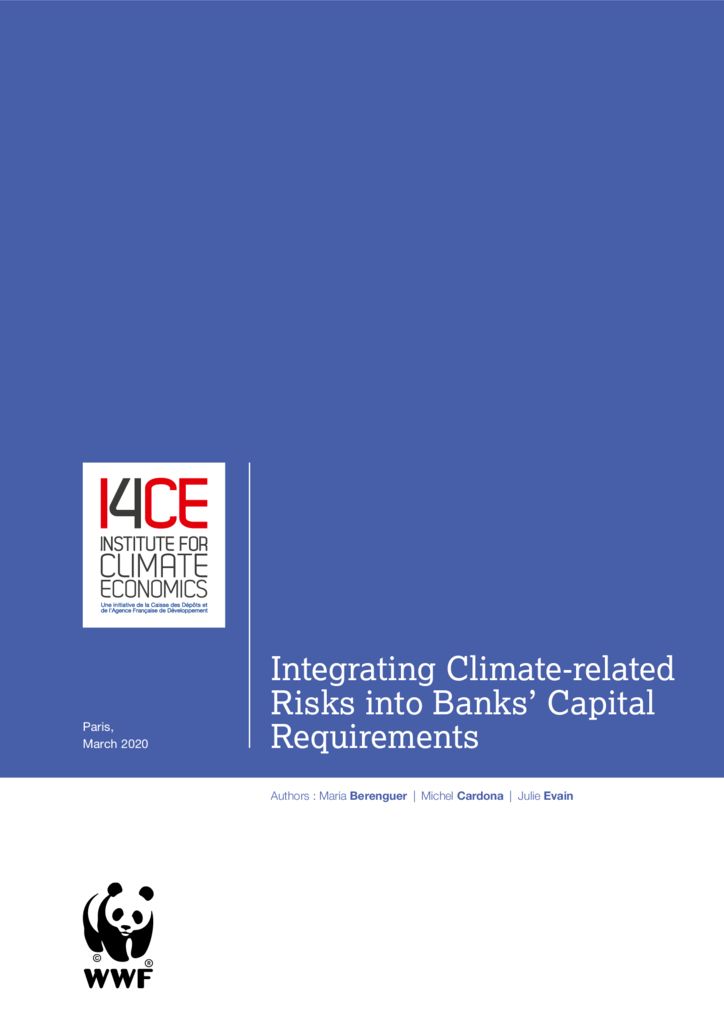Integrating Climate-related Risks into Banks’ Capital Requirements
Climate change dynamics are on a trajectory of intensification which may require the use of new and notable measures. The Paris Agreement recognized the urgency of directing financial flows toward low carbon activities and climate-resilient development. However, the latest special Intergovernmental Panel on Climate Change (IPCC) report 1 stated that to limit global warming to 1.5oC, the financial resources directed to green activities are by far insufficient and investments on carbon intensive projects are still far too high. At the same time, climate-related risks continue to potentially endanger the stability of the financial sector and they are only marginally addressed by Basel III capital requirements.
This situation gave rise to the discussion about using capital requirements to address both the climate investment gap and climate-related risks. The debate has gained more attention in Europe with the mandate given early 2019 by the Commission to the European Banking Authority (EBA) to report on the possibility of introducing a prudential treatment in accordance with environmental and social objectives 2. Stakeholders have taken part in this debate with strong and opposing views.
Different approaches and objectives
To date, the debate has been often confused due to a mixing up of different possible objectives and conditions for implementing such regulatory measures. It is therefore key when looking at integrating climate-related risks into capital requirements to distinguish between two different approaches:
– The risk approach, which seeks to increase banks’ resilience to climate-related risks and thereby ensure financial stability. It is as well the approach that corresponds to primary objective of capital requirements;
– The economic policy approach, which aims to use capital requirements as a policy tool to channel financial flows towards a low-carbon economy.
Different possible regulatory instruments
There are very few examples of existing capital requirement adjustments to learn from in order to inform the debate. The most relevant one is the Small and Medium Enterprise (SME) supporting factor put in place in 2014 by the EU to support credit to SMEs; however, the outcomes of this measure are still unclear, inconclusive and debated. In order to integrate climate-risks into capital requirements, several mechanisms have been so far put forward: a Green Supporting Factor (GSF), a Brown Penalizing Factor (BPF), the combination of a GSF and a BPF, an Environment-Risk Weighted Asset (ERWA) and a Green Weighting Factor which is the only one already implemented on a voluntary basis by Natixis, a French commercial bank. All of them have their advantages and disadvantages which differ according to theapproach chosen. All the reviewed instruments are not equally fit to meet each possible approach:
– Under the risk approach, using a Green Supporting Factor or a Brown Penalizing Factor alone would face a major weakness: the risk approach would require recalibrating the risk weight factors of all assets to fully integrate climate-risks in banks’ balance sheet and not only part of them. In this respect, the combination of a GSF and a BPF – or any similar mechanism – would make a step in the right direction by covering all assets. However, it would still assume that the climate adjusted risk weight of green assets should be lower than their current risk weight whereas it is likely that they would remain constant at best.
– On the contrary, under the economic policy perspective, none of the reviewed instruments can be disregarded ex ante.
Click on this button to see the image
Different challenges for implementation
Moreover, specific challenges would need to be addressed before implementing any of these measures at a national level:
– Under the risk approach, the objective is to integrate climate-related risks to maintain financial stability. Therefore, it is key to accurately measure the level of climate-risks associated to each asset. This is still a major challenge because of the deep uncertainty nature of climate change and socio-economic measures associated– and as a result the lacking usefulness of historical data –and the short-term horizon of standard credit risk models compared to the medium-long term horizon of climaterelated risks. In the absence of a sufficiently robust risk measure, there is no point in taking the risk approach.
– Under the economic policy approach, the objective is to channel more flows toward the low-carbon economy. The issue of accurately measuring climate-risks is no longer essential. The question is rather to find a metric which allows to differentiate among activities based on their contribution to developing a low-carbon economy. In this situation, however, other challenges would still exist. The first one relates to the effectiveness of adjusting banks’ capital requirements to increase or reduce specific categories of credits. Indeed, there is no clear empirical evidence supporting such effectiveness. The second challenge is to ensure this policy instrument would not endanger financial stability. To do so, it would be key to maintain banks’ capital base in line with prudential requirements as measured today based on the lessons drawn from the recent global financial crisis. This raises the question of how capital neutrality should be ensured at the starting point, possibly through a micro adaptation of the mechanism, and whether it should be maintained over time which would entail rather complex mechanisms.
The paper stresses that pursuing the risk and the economic policy objectives together can create tensions in the design of the capital requirement adjustment for certain types of financings. It may be necessary to give preference to one objective, probably to the detriment of the other.
In addition, a common taxonomy would be helpful for the risk approach to screen the assets vis-à-vis their transition impact and would be a pre-condition to follow the policy tool approach. Depending on the instrument chosen, this taxonomy could be ‘green’ – as the European Union’s (EU) taxonomy – or ‘green and brown’ as requested by regulators of the NGFS.
Finally, there are issues which will require further discussions. It would be important to clarify points such as the bias of methodologies, the capital neutrality in the long run and the lack of empirical evidence.
Discover our video: Climate change, what integration in bank’s capital requirement?
Maria Berenguer from I4CE explains two different approaches in order to ntegrate climate risks into banks capital requirement:
1. Global Warming of 1.5°C report
2. European Commission, “Adoption of the banking package: revised rules on capital requirements (CRR II/CRD V) and resolution (BRRD/SRM)”.

